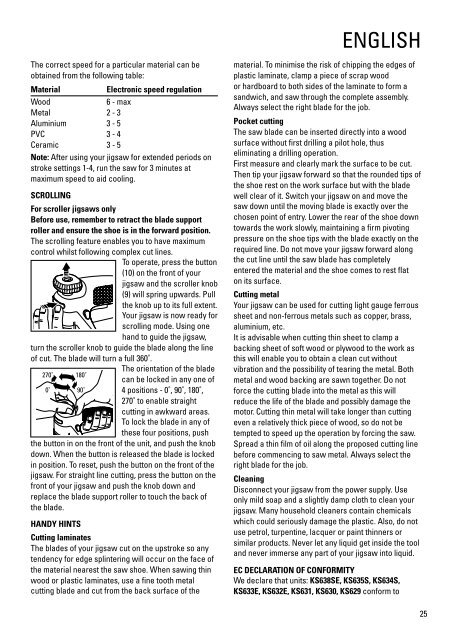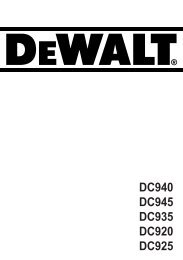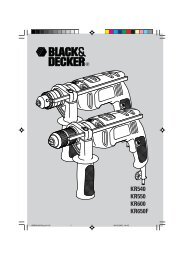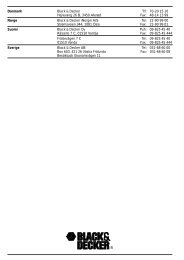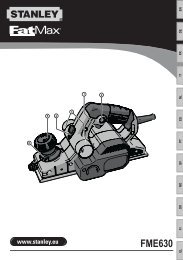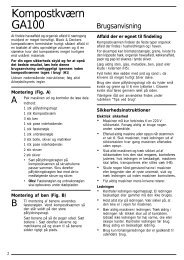Create successful ePaper yourself
Turn your PDF publications into a flip-book with our unique Google optimized e-Paper software.
The correct speed for a particular material can be<br />
obtained from the following table:<br />
Material<br />
Electronic speed regulation<br />
Wood<br />
6 - max<br />
Metal 2 - 3<br />
Aluminium 3 - 5<br />
PVC 3 - 4<br />
Ceramic 3 - 5<br />
Note: After using your jigsaw for extended periods on<br />
stroke settings 1-4, run the saw for 3 minutes at<br />
maximum speed to aid cooling.<br />
SCROLLING<br />
For scroller jigsaws only<br />
Before use, remember to retract the blade support<br />
roller and ensure the shoe is in the forward position.<br />
The scrolling feature enables you to have maximum<br />
control whilst following complex cut lines.<br />
To operate, press the button<br />
(10) on the front of your<br />
jigsaw and the scroller knob<br />
(9) will spring upwards. Pull<br />
the knob up to its full extent.<br />
Your jigsaw is now ready for<br />
scrolling mode. Using one<br />
hand to guide the jigsaw,<br />
turn the scroller knob to guide the blade along the line<br />
of cut. The blade will turn a full 360˚.<br />
The orientation of the blade<br />
270˚ 180˚<br />
can be locked in any one of<br />
0˚ 90˚ 4 positions - 0˚, 90˚, 180˚,<br />
270˚ to enable straight<br />
cutting in awkward areas.<br />
To lock the blade in any of<br />
these four positions, push<br />
the button in on the front of the unit, and push the knob<br />
down. When the button is released the blade is locked<br />
in position. To reset, push the button on the front of the<br />
jigsaw. For straight line cutting, press the button on the<br />
front of your jigsaw and push the knob down and<br />
replace the blade support roller to touch the back of<br />
the blade.<br />
HANDY HINTS<br />
Cutting laminates<br />
The blades of your jigsaw cut on the upstroke so any<br />
tendency for edge splintering will occur on the face of<br />
the material nearest the saw shoe. When sawing thin<br />
wood or plastic laminates, use a fine tooth metal<br />
cutting blade and cut from the back surface of the<br />
ENGLISH<br />
material. To minimise the risk of chipping the edges of<br />
plastic laminate, clamp a piece of scrap wood<br />
or hardboard to both sides of the laminate to form a<br />
sandwich, and saw through the complete assembly.<br />
Always select the right blade for the job.<br />
Pocket cutting<br />
The saw blade can be inserted directly into a wood<br />
surface without first drilling a pilot hole, thus<br />
eliminating a drilling operation.<br />
First measure and clearly mark the surface to be cut.<br />
Then tip your jigsaw forward so that the rounded tips of<br />
the shoe rest on the work surface but with the blade<br />
well clear of it. Switch your jigsaw on and move the<br />
saw down until the moving blade is exactly over the<br />
chosen point of entry. Lower the rear of the shoe down<br />
towards the work slowly, maintaining a firm pivoting<br />
pressure on the shoe tips with the blade exactly on the<br />
required line. Do not move your jigsaw forward along<br />
the cut line until the saw blade has completely<br />
entered the material and the shoe comes to rest flat<br />
on its surface.<br />
Cutting metal<br />
Your jigsaw can be used for cutting light gauge ferrous<br />
sheet and non-ferrous metals such as copper, brass,<br />
aluminium, etc.<br />
It is advisable when cutting thin sheet to clamp a<br />
backing sheet of soft wood or plywood to the work as<br />
this will enable you to obtain a clean cut without<br />
vibration and the possibility of tearing the metal. Both<br />
metal and wood backing are sawn together. Do not<br />
force the cutting blade into the metal as this will<br />
reduce the life of the blade and possibly damage the<br />
motor. Cutting thin metal will take longer than cutting<br />
even a relatively thick piece of wood, so do not be<br />
tempted to speed up the operation by forcing the saw.<br />
Spread a thin film of oil along the proposed cutting line<br />
before commencing to saw metal. Always select the<br />
right blade for the job.<br />
Cleaning<br />
Disconnect your jigsaw from the power supply. Use<br />
only mild soap and a slightly damp cloth to clean your<br />
jigsaw. Many household cleaners contain chemicals<br />
which could seriously damage the plastic. Also, do not<br />
use petrol, turpentine, lacquer or paint thinners or<br />
similar products. Never let any liquid get inside the tool<br />
and never immerse any part of your jigsaw into liquid.<br />
EC DECLARATION OF CONFORMITY<br />
We declare that units: KS638SE, KS635S, KS634S,<br />
KS633E, KS632E, KS631, KS630, KS629 conform to<br />
25


